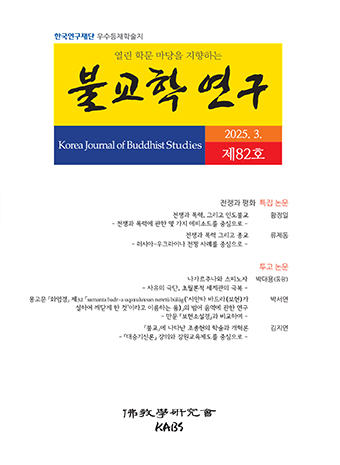- 영문명
- Investigating the Therapeutic Potential of Early Yogācāra Practice for Trauma Healing: A Focus on the Path to Liberation Sūtra
- 발행기관
- 불교학연구회
- 저자명
- 조인숙(In-Sug CHO)
- 간행물 정보
- 『불교학연구』제84호, 299~328쪽, 전체 30쪽
- 주제분류
- 인문학 > 불교학
- 파일형태
- 발행일자
- 2025.09.30

국문 초록
본 연구는 유가행파 수행 체계 형성에 지대한 영향을 준 『수행도지경』(이하 『경』을 중심으로, 그 수행법이 현대 심리치료, 특히 트라우마 치유에 어떻게 적용될 수 있는지를 고찰하였다. 최근 한국 사회는 반복되는 재난과 사고로 인해 외상 후 스트레스 장애(PTSD), 불안, 우울 등 심리적 고통이 심화되고 있으며, 이에 따라 통합적이고심층적인 치유 접근이 요구된다. 『경』에 제시된 오온 해체, 수식관, 자비관, 공관 등의수행은 심리적 자동반응의 자각과 해체, 정서 회복, 자기 인식 구조의 재편을 통해 트라우마 치유의 각 단계와 밀접하게 대응된다. 유식학의 아뢰야식과 전의(轉依) 개념은 기억 재구조화 이론과 유사한 구조를 가지며, 고착된 반응 양식을 근원적으로 전환하는 실천적 틀을 제공한다. 특히 공관 수행은 존재에 대한 집착과 왜곡된 자기상을 해체하고, 감정·신념·기억의 통합적 전환을 가능케 한다. 이와 같이 『경』의 수행체계는 트라우마 회복을 위한 통합적 심신 치유 모델로 기능할 수 있으며, 전통 명상법의 현대 임상 활용 가능성을 뒷받침하는 이론적·실천적 근거를 제공한다.
영문 초록
This study explores the therapeutic relevance of the Path to Liberation Sūtra (Xiuxing Daodi Jing, 修行道地經), a foundational text of early Yogācāra, in the context of modern trauma recovery. With increasing rates of post-traumatic stress disorder, anxiety, and depression in contemporary Korean society, there is a growing demand for integrative healing models that bridge ancient contemplative traditions with modern psychology.
The sūtra presents a structured meditation path—including deconstruction of the five aggregates, mindfulness of breathing (ānāpānasmṛti), compassion meditation, and contemplation of emptiness—that closely parallels the stages of trauma healing: awareness, stabilization, and integration. These practices foster emotional regulation, cognitive flexibility, and somatic awareness, while also facilitating the transformation of deeply held beliefs and identity structures.
Key Yogācāra concepts such as ālayavijñāna (storehouse consciousness) and parāvṛtti (transformation of the basis) resonate with contemporary theories of memory reconsolidation, suggesting a psychological mechanism through which trauma-related imprints may be restructured.
This study argues that the Path to Liberation Sūtra provides not only a philosophical framework but also practical methods directly relevant to trauma-informed contemplative therapy. It offers insight into how Buddhist meditative systems can inform integrative approaches to psychological healing, rooted in both inner transformation and embodied awareness.
목차
I. 들어가며
II. 트라우마와 유식학의 심층기억 이론
III. 『수행도지경』의 수행 체계
IV. 통합적 논의: 『수행도지경』 수행과 트라우마 치유 단계의 상응 구조
V. 마치며
참고 문헌 REFERENCES
키워드
해당간행물 수록 논문
참고문헌
최근 이용한 논문
교보eBook 첫 방문을 환영 합니다!

신규가입 혜택 지급이 완료 되었습니다.
바로 사용 가능한 교보e캐시 1,000원 (유효기간 7일)
지금 바로 교보eBook의 다양한 콘텐츠를 이용해 보세요!


